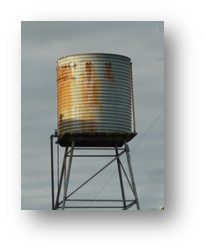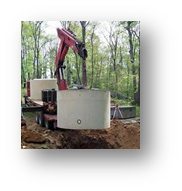Tank Material Comparison
Water tanks are available in a range of suitable materials including plastic, galvanised steel, stainless steel, Aquaplate®, Zincalume®, Steel Liners, fibreglass, and concrete.
If the water is to be used for human consumption, then the tank material should comply with the requirements of potable-water standard (AS/NZS4020).
New water tanks can sometimes impart specific tastes and odours. For example, galvanised tanks can impart a metallic taste when first filled, due to leaching of excess zinc. New concrete tanks can release excess lime, leading to a high pH and possibly a bitter taste. Water from other types of tanks tend to be slightly acidic.
Plastic (Poly) Tanks
The most popular type of water tank in Australia is the plastic or poly water tank, typically made with the rotational moulding process. Bushman’s tanks have been manufactured using this process for over 30 years. Plastic tanks and plastic liners must be constructed of materials that are at least of food-grade standard (compliant with AS 2070) and if the water is to be used for human consumption the plastic material must comply with the requirements of potable-water standard (AS/NZS4020). Bushmans tanks comply with the raw material requirements of the Australian Tank Standard. The rotational moulding industry is one of the few industries that have a comprehensive standard that covers both the raw materials used, and the manufacturing and workmanship of the completed water tanks.
Polyethylene (Poly) is non-corrosive for long life. Polyethylene will not rust or suffer from corrosion as will metal water tanks so time during their service life.
Poly tanks are lightweight and easy to handle – no heavy equipment needed.
Poly tanks are made in one single piece. They have no joints or seams where part of the tank has been welded together, and no sealants are used to join any parts of the tank together.
Bushmans poly water tanks are manufactured from materials that comply with the light transmission standard (AS/NZS4766) that inhibits the growth of algae. Light transmission is a potential problem that fiberglass tanks also need to manage.
Bushmans poly tanks contain long term UV light protection that exceeds the requirements of the Australian Standard. Independent testing has shown that some of the most popular colours Bushmans manufacture exceed the minimum UV requirements by over 300%. Bushmans poly tanks have been in service since 1989 in the harsh Australian environment. They have managed to survive the sun and the heat, proving that Bushmans tank design and manufacturing process is second to none.
Polyethylene tanks can be recycled at the end of their service life. Recycled plastic cannot make water tanks because potable water regulations only allow virgin plastics to be used. However, there are many other product applications for recycled plastic. The recycled plastic can have new sun and heat protection added, and go on to enjoy another long life.
Steel Liner Tanks
Steel liner tanks are steel water tanks that have a poly liner which holds the water in the tank. The benefit of the poly liner is it prevents water coming into contact with the galvanised or Zincalume® walls preventing corrosion, and the liner is ideal for storage of potable water. The poly liner material should comply with the requirements of potable-water standard (AS/NZS4020) if water is to be used for human consumption.
The key benefits of the steel liner tanks are the liner and its capacity to hold water, and the modular steel structure which allows very large tanks to be assembled on site which is more affordable than similar sized concrete tanks.
These tanks are made from either galvanised materials or Zincalume®. The benefits of the Zincalume® tank is it has a slightly lower cost, however for effective corrosion protection, it should have a sacrificial anode. This anode should be replaced every 5 years.
The galvanised tank is fully galvanised with all material walls, trusses and fittings being fully compatible. Galvanised walls are more corrosion resistant in a tank application and there is no need for a sacrificial anode.
Steel Water Tanks
In generations past most water tanks were made from galvanised steel which are the water tanks we are familiar with on older buildings and sheds. The key with these is the corrosion protection with these tanks were limited and hence the life of the tank was relatively short. This is especially the case without added corrosion protection such as Aqualplate®. Galvanised steel has a lot lower resistance to corrosion then polyethylene and hence the move to poly tanks over the past few years.
The other innovation has been the introduction of steel tanks with a poly liner.
If there is direct contact with water in the tank and the zinc wall this maybe leached into the tank and can at times affect the taste of stored rainwater but is not a health risk. Ideally galvanised water tanks should flushed before use.
The key material in steel tanks is galvanised steel. The galvanising process involves the application to the metal of a zinc based coating. These galvanised sheets are then solders or joined by a silicon sealant. Solder consists is made from mixture of lead & tin which is melted with a hot iron and applied to a joint. The silicon sealant must be extensively tested to ensure the tank is water tight.
Aquaplate® (plastic coated steel) is product that is specifically designed for water tanks. The product has a food grade polymer surface or coating joined to the base galvanised steel material. Note the polymer material used in plastic coated steel is not resistant to long exposure to sunlight, so that tank inside surface requires a top cover protecting it from the sun at all times. Chemicals typically used as mosquito larvicides can cause deterioration of the polymer coating.
When cleaning the tank the polymer coating must not be damaged as this will expose the tank to corrosion. If the coating is damaged, it should be repaired immediately.
Steel used in the fabrication of water tanks typically has a warranty of 20 years. The manufactured product (the water tank) generally has a 10 year warranty, on a pro-rata basis. This is because joins are the areas of greatest risk of failure. You should read the warranty thoroughly. Most steel tank installations require concrete slab, minimum 100mm thick with steel reinforcing, or else you void the warranty.
Stainless Steel Tanks
Stainless steel can also be used to manufacture water tanks. This material does not suffer from the rust or corrosion problems of typical steel tanks. However, the cost of stainless steel is significantly higher than normal coated steel tanks, and significantly more expensive than plastic tanks. The stainless-steel tanks still require a seam, where the sheets are joined.
Concrete Tanks
Concrete water tanks and ferro-cement water tanks are very strong and long-lasting. They are very heavy, and difficult to handle. 5000G tank would weigh about 8Mt. Concrete water tanks are most often installed underground however smaller tanks are available for above ground.
New concrete water tanks often impart tastes and may leach lime thereby increasing the pH of water. Accordingly, these concrete water tanks may need to be flushed before use.
Concrete tanks can either be delivered complete for small or medium sized concrete water tanks, or poured on site for medium and larger concrete water tanks.
Concrete water tanks delivered on site in a complete form are craned off the truck and onto a prepared sand base. These tanks are sometimes in one to three pieces. Concrete sections are sealed primarily with a rubber or synthetic sealing ring or some form of sealant. Sealant is then applied to the inside of the tank at the join to stop the water leaking out.
Concrete water tanks are usually the most affordable for an underground solution. They are ideal for this purpose because they can be covered with load-bearing lids and can fit under driveways or other structures.
Cracking and leaking is one of the most common complaints suffered by concrete tanks. As long as the tank can be drained, the cracks can be repaired. In some bad cases, a plastic liner is required, which can be very expensive.
The standard for concrete tanks allows for a certain amount of leakage, while the standard for plastic tanks does not allow any leakage.
Fibreglass
Fibreglass tanks (or GFRP Glass Fibre Reinforced Plastic) are available to store water. These tanks must be manufactured with a food-grade coating on their interior surface. The coating is cured before the tanks are offered for sale.
One advantage of Fibreglass is that it is very stiff or rigid. This means that tank walls can be relatively thin to manage the water pressure. However, the disadvantage of this very rigid material is that it can tend to be brittle in nature, being prone to cracking and leaking.
Most Fibreglass tanks have a resin, which is mixed with a catalyst or hardener, along with glass fibres (reinforcement) sprayed onto a mould by an operator. The process is dependent on the skill of the individual. As a result, the process can result in variation from tank to tank.
Fibreglass water tanks allow more light entry than other types of tanks, which encourages algal growth. To prevent this, tanks should be sealed with a black covering inside or painted on the outside. Some tanks are manufactured with sufficient pigment to prevent this problem occurring.
Fire Resistance
Steel, steel liner and concrete tanks are fire proof. Although a bush fire cannot burn the steel besides making it black, prolonged exposure to extreme temperatures will eventually destroy the seal of tanks where there is a plastic resin used on the tank loins. The impact of this will depend on how much water is in the tank.
Plastic tanks can ignite when there is a sustained ignition source, such as a high intensity bush fire. If a water tank is required to provide guaranteed water supply for the fire service, we would recommend a steel liner, concrete tank or an underground water tank.
Plastic coated steel tanks, contrary to what some tank manufacturers state, are sensitive to temperature over 70 degrees. The plastic coating inside the tank will separate and render the tank useless. Zincalume® will perform slightly better than Aquaplate®, up to about 200 degrees when the Zincalume® coating will melt.




